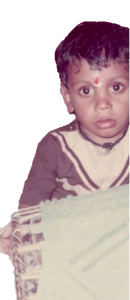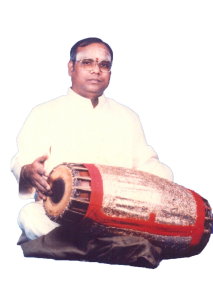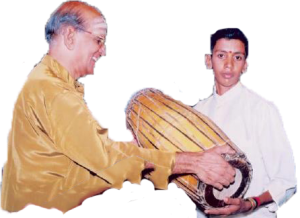Family
R Sankaranarayanan is the younger son of Papanasam Sri Ramani Bhagavathar, great-grandson of Brahmasri Papanasam Sri Rajagopala Iyer — elder brother of the illustrious composer and musician Sangeetha Kalanidhi Papanasam Sivan. His father, Sri. Ramani Bhagavathar is one of the direct disciples of Papanasam sivan and an eminent Namasankeerthanam exponent. In pozhichalur near
 pallavaram, a chennai suburb, Sankaranarayanan was born in a house reverberating with music which sowed the seed for his laya interest. His parents encouraged his taste in rhythm.
pallavaram, a chennai suburb, Sankaranarayanan was born in a house reverberating with music which sowed the seed for his laya interest. His parents encouraged his taste in rhythm.
Humble beginnings
Sankaranarayanan used to play with empty palm-oil tins at the age of three as the original mridangam was too big for his little hands to reach! He started accompanying his father’s bhajans and namasankeerthanam programmes from the age of five. For about three years, Sankaranarayanan played on the dholki, a north indian percussion instrument. By the time he was eight, he had been on an all India tour with the devotional singer Pithukuli Murugadoss. And when he was nine years old he started accompanying various artistes for carnatic concerts.
Gurus
 Sankaranarayanan developed a taste for rhythm and an interest in mridangam came by watching mridangam vidwans like Kumbakonam Sri Ganesan, Mellatur Sri Balasubramanian, Pammal Sri Krishnamoorthy and Papanasam Sri Kumar accompany his father for concerts and namasankeerthanam programmes.
Sankaranarayanan developed a taste for rhythm and an interest in mridangam came by watching mridangam vidwans like Kumbakonam Sri Ganesan, Mellatur Sri Balasubramanian, Pammal Sri Krishnamoorthy and Papanasam Sri Kumar accompany his father for concerts and namasankeerthanam programmes.
He also had the initial mridangam lessons from them for few months. At the age of eleven, Mridangam maestro Kalaimamani Srimushnam Sri V Rajarao spotted his talent in his father’s namasankeerthanam programme on the day of Saraswathi pooja and he gracefully accepted to teach him from the very next day, the auspicious Vijayadasami. He learnt from his guru in the traditional gurukulam way by being together with him for most part of the day, accompanying him for concerts, practising and taking lessons from him. Instead of arangetram as it happens nowadays Sankaranarayanan was introduced in the traditional way where he accompanied along with his guru Sri. Rajarao in a temple concert that happened in the Sanatorium Rama Anjaneya temple during Vinayaka chathurthi festival. He owes to his guru Sri. Rajarao the fingering techniques, various patterns, instrument’s intricacies, accompanying nuances and all other performing aspects that he has learnt till date.
Education
Sankaranarayanan completed B.A and M.A in Sanskrit from Vivekananda college which is known to hone and encourage musicians and artistes. He then took up M.Phil in the topic “Depiction of Mridangam in Sanskrit literature” and completed that as the University topper.
He has presented papers in a number of conferences on various topics like “Music instruments in Mahabaratha”, etc…
Some cherishable moments…
Once he had the good fortune of accompanying the Paramacharya of Kanchi, Jagadguru Sri Chandrasekara Saraswathi for the abhang “Sundarathe Dhyana” and was blessed on his head with his holy hands and was given a garland of cardamom worn by the sage himself!
 A memorable moment was when for double mridangam he accompanied Sikkil Sisters along with his guru Srimushnam Sri.V.Rajarao in the famous Tirupathi Thyagaraja Festival.
A memorable moment was when for double mridangam he accompanied Sikkil Sisters along with his guru Srimushnam Sri.V.Rajarao in the famous Tirupathi Thyagaraja Festival.
Other unforgettable memories are of getting Mridangam as prize in contests from Sankaranarayanan’s inspiration among the legends, Padma Vibushan Umayalpuram Sri.K.Sivaraman in Krishna Gana Sabha and Sangeetha Kalanidhi Palghat Sri.Raghu in Shanti Arts Foundation and Endowment (SAFE)
